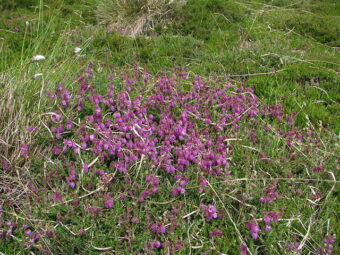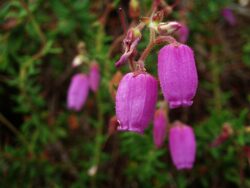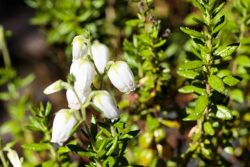In this article, we will discuss how to grow the not often seen Daboecia in containers. If you look in gardens throughout the UK, you will see Callunas and Ericas grown everywhere but you will not see Daboecias. This is very puzzling because like its cousins, it is not more difficult to grow and they require the same growing conditions.

Daboecia is a small species of flowering plants of the Ericaceae (the Erica or Heath) family, where only 3 species are known to exist, Daboecia gets its name from the Irish Saint Dabheog.
It is a shrub that is native to cliffs and heathlands in Southern Europe and the Azores, especially Ireland. Of the species, you will find Daboecia cantabrica is the more eye-catching. It has wiry stems bearing 1.25cm long, evergreen leaves. The stems grow up to 45cm long and are topped by a vast array of white, pink or lilac bell-shaped flowers. The flowers are produced at the same time as heathers but have a remarkable longer flowering period.
The difference between Daboecia and other species of Erica is that the Corolla are much larger. It is a bit on the tender side but it will normally handle Irish winters but if you regularly get harsh winters, you will need to move it under the protection of a greenhouse. The one major drawback is that the blooms are not extensive as other heathers and are not born all around the flower stalks.
Find out how to grow this wonderful colourful shrub of Daboecia in containers.
GROWING DABOECIA IN CONTAINERS
You will need a large container with plenty of drainage holes. Make sure that the container is well balanced with the plant in question and will blend with the garden scheme you have in mind. Fill the container with a 2cm layer of gravel to help with drainage even further and on top of this add up to 5cm below the rim with ericaceous compost.
Dig a hole in the centre of the container slightly bigger than the root ball it came in the pot you bought the plant in. Place the plant in so that the top of the root ball is at the same level as the top surface of the compost. Backfill with the growing media so that it fits in properly and no gaps remain, using more ericaceous compost if necessary. Firm the plant in and water well.
BEST GROWING CONDITIONS
This is one plant that will do well in full sun or partial shade, as long as it is not grown in full shade.
Like all heathers, it will not need feeding unless it is obviously showing signs of nutrient deficiency. It will not harm if you give an annual dressing with slow-release ericaceous fertilizer at half its recommended dosage. Only feed once per season.

This is one Erica that appreciates being watered regularly, even if established. It is best to water when 5cm below the top surface of the compost feels dry to the touch. When watering make sure to use rainwater and to do so until the water emerges from the drainage holes.
Pruning is only a minimum effort, as all you need to do is trim the plant lightly to remove faded flower heads as soon as blooming has finished. At the same time, you can cut straggly stems to make it look neater,
Propagation is also a simple matter as well. All you need to do is take a 5cm cutting in summer and place it in a pot full of ericaceous compost in a cold frame. Allow it to grow on for planting out next year.
PESTS AND DISEASES
This is one tough plant and does not readily suffer from pests and disease. As said in the introduction, it cannot take harsh winters, unlike other heathers. It is recommended for those who regularly suffer from – 10 degrees Celsius temperatures that it would be better to bring the container inside a well-insulated greenhouse or protection of a home.
VARIETIES TO GROW
There are two main species that you are likely to find.

The easier one to find is Daboecia cantabrica whose leaves are purplish-green and are silvery below. The standard variety has pale purple flowers, but other varieties have flower colours in white, light pink or dark purple. The white variety is called ‘Alba’, whilst the dark purple variety is ‘Atropurpea’. If pink is your colour then ‘Praegerae’ is for you, whilst ‘Bicolor’ produces white and purple flowers.
The other species you can find is Daboecia x scotica which is slightly taller. The varieties to look out for are ‘Jack Drake’ which has deep red flowers and ‘William Buchanan’ which has deep purple flowers.
CONCLUSIONS
In this article, we have discussed how to grow the pretty and not-so-often seen plant of Daboecia in containers. They are easy to care for, easy to look after and make a great alternative to the Callunas and Ericas so often seen in so many gardens, the colours go from pure white to deep purple, so make a great addition to the container garden.
If you have any questions or comments that you wish to make on growing Daboecia in containers, please do so in the comment box below.
Happy Daboecia growing.
